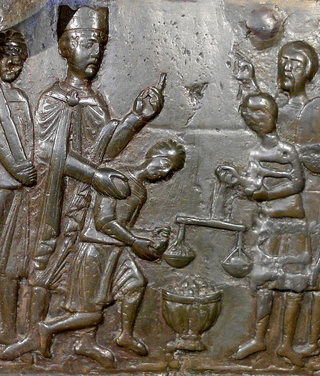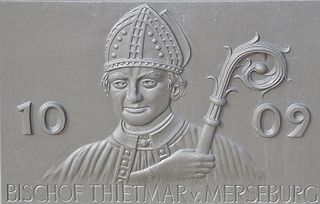This article includes a list of general references, but it lacks sufficient corresponding inline citations .(January 2017) |
Eido I, also Ido, Eid or Ägidius (955 – 20 December 1015), was the bishop of Meissen from 992 to 1015.
This article includes a list of general references, but it lacks sufficient corresponding inline citations .(January 2017) |
Eido I, also Ido, Eid or Ägidius (955 – 20 December 1015), was the bishop of Meissen from 992 to 1015.
Eido, thought to have been a member of the noble von Colditz family, belonged to the cathedral chapter of Magdeburg. His appointment as bishop of Meissen in 992 was on the recommendation of Giselher, Archbishop of Magdeburg.
Among the major events of his period of office was the dispute over the restoration of the bishopric of Merseburg, which had been abolished in 981 by the efforts of Giselher, and of its territories to the east of the Mulde which had fallen to the bishopric of Meissen. Eido was successful in retaining those territories for Meissen even after the restoration of the bishopric of Merseburg in 1004. Although measures had been taken in the court of Otto III to readjust the boundaries, they remained without effect.
Bishop Thietmar of Merseburg, appointed in 1009, reported in Book 7 of his Chronicle that Eido died on 20 December 1015 while travelling through urbs Libzi: this is the first written reference to the town of Leipzig. His body was escorted by Hildeward, bishop of Zeitz, back to Meissen, where it was buried.

Merseburg is a town in central Germany in southern Saxony-Anhalt, situated on the river Saale, and approximately 14 km south of Halle (Saale) and 30 km west of Leipzig. It is the capital of the Saalekreis district. It had a diocese founded by Archbishop Adalbert of Magdeburg. The University of Merseburg is located within the town. Merseburg has around 33,000 inhabitants.

Bolesław I the Brave, less often known as Bolesław the Great, was Duke of Poland from 992 to 1025, and the first King of Poland in 1025. He was also Duke of Bohemia between 1003 and 1004 as Boleslaus IV. A member of the ancient Piast dynasty, Bolesław was a capable monarch and a strong mediator in Central European affairs. He continued to proselytise Western Christianity among his subjects and raised Poland to the rank of a kingdom, thus becoming the first Polish ruler to hold the title of rex, Latin for king.

The Congress of Gniezno was an amicable meeting between the Polish Duke Bolesław I the Brave and Emperor Otto III, which took place at Gniezno in Poland on 11 March 1000. Scholars disagree over the details of the decisions made at the convention, especially whether the ruler of Poland was pledged the king's crown or not.

Henry I, known as Henry the Strong, was the Margrave of Austria from 994 to his death in 1018. He was a member of the House of Babenberg.

Thietmar, Prince-Bishop of Merseburg from 1009 until his death, was an important chronicler recording the reigns of German kings and Holy Roman Emperors of the Ottonian (Saxon) dynasty. Two of Thietmar's great-grandfathers, both referred to as Liuthar, were the Saxon nobles Lothar II, Count of Stade, and Lothar I, Count of Walbeck. They were both killed fighting the Slavs at the Battle of Lenzen.

Taucha is a town in the district of Nordsachsen, in Saxony, Germany. It is situated on the river Parthe, 10 km northeast of Leipzig.
The Bishopric of Merseburg was an episcopal see on the eastern border of the medieval Duchy of Saxony with its centre in Merseburg, where Merseburg Cathedral was constructed. The see was founded in 967 by Emperor Otto I at the same time in the same manner as those of Meissen and Zeitz, all suffragan dioceses of the Archbishopric of Magdeburg as part of a plan to bind the adjacent Slavic ("Wendish") lands in the Saxon Eastern March beyond the Saale River more closely to the Holy Roman Empire.

The Diocese of Görlitz is a diocese of the Roman Catholic church in Germany. The current ordinary is Wolfgang Ipolt
Theodoric I was a nobleman in the Duchy of Saxony, and the oldest traceable member of the House of Wettin.
Matilda, also known as Mathilda and Mathilde, was a German regent, and the first Princess-Abbess of Quedlinburg. She served as regent of Germany for her brother during his absence in 967, and as regent during the minority of her nephew from 984.
Oda of Meissen, also named Ode, Old High German form for Uta or Ute, was a Saxon countess member of the Ekkehardiner dynasty. She married Piast Duke Bolesław I the Brave as his fourth and last wife.

In the Slavic revolt of 983, Polabian Slavs, Wends, Lutici and Obotrite tribes, that lived east of the Elbe River in modern north-east Germany overthrew an assumed Ottonian rule over the Slavic lands and rejected Christianization under Emperor Otto I.
Christoph von Stadion (1478–1543) was Prince-Bishop of Augsburg from 1517 to 1543.
The German royal election of 1002 was the decision on the succession which was held after the death of Emperor Otto III without heirs. It was won by Duke Henry IV of Bavaria among accusations of uncustomary practices.

Lorenz Hubert Weinrich is a German historian.
Saint Burchard of Meissen was the first Bishop of Meissen, from 968.
Volkold of Meissen was the second Bishop of Meissen.
Eido II, was Bishop of Meissen from 1040 to 1045 or 1046.
Hathui was a member of the Saxon House of Billung, who was the first abbess of Gernrode (r.959-1014).